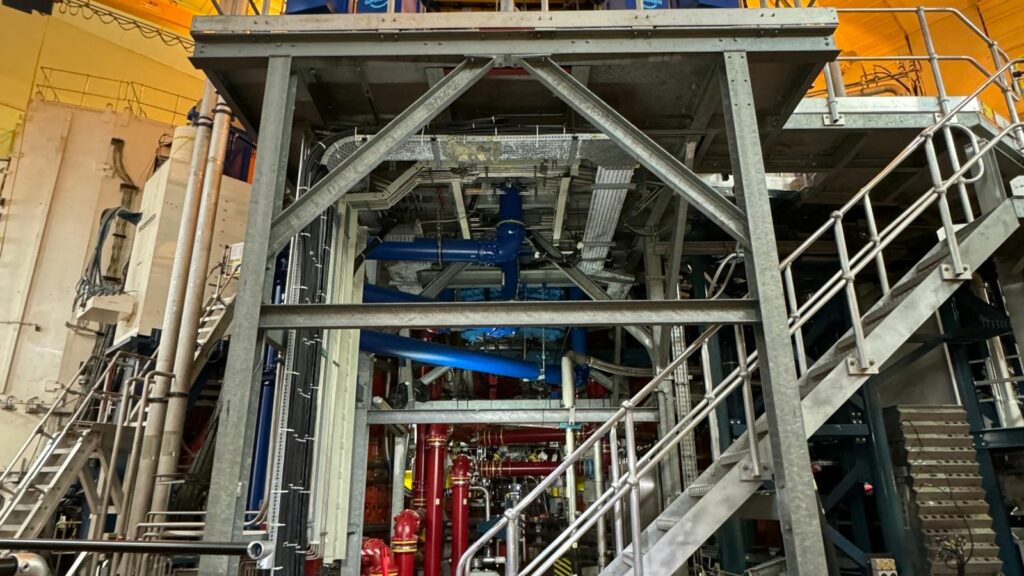Machine designed to replicate the conditions inside a burning star shutting down | Science & Tech News

It was only a few weeks ago that scientists at the Joint European Torus (JET) in Oxfordshire announced the nuclear fusion experiment had broken a world record.
The machine – designed to replicate the conditions inside a burning star – generated a five-second pulse of fusion, releasing 69 megajoules of energy.
If JET was a power plant, not an experiment, and that energy harnessed, it could have powered 12,000 homes.
But that pulse was to be JET’s last.
After 40 years of fusion science, it’s being decommissioned.
Given the promise of fusion power – providing near limitless, emissions-free energy – shutting down JET may sound like an odd move.
The Joint European Torus in Oxfordshire is shutting down
But JET was always an experiment, and because of it, the science and engineering has moved on since it opened in 1983.
Back then it wasn’t even certain that a machine of JET’s design – a hollow donut-shaped vessel in which magnets contain and heat a plasma of heavy hydrogen atoms to temperatures of 150 million degrees – could be used to contain, and sustain, a fusion reaction.
But the thousands of scientists and engineers that have run JET have now proved that it is.
JET’s design was used to inform the design and construction of the ITER (International Thermonuclear Experimental Reactor) fusion reactor – a vast fusion machine being built by an international consortium, led by the EU and including China, India, Korea, Japan, Russia and the USA.

JET’s design was used to inform the design of the ITER a vast fusion machine being built by and international consortium
In recent years JET has been testing the science and reactor materials that will be used by ITER once it begins operations.
But JET’s retirement celebrations are tinged with uncertainty. On leaving the EU, the UK forfeited its membership of ITER and has now decided not to continue as a fully paid-up member of the project.
Many fusion scientists feel that’s a poor return on the decades of investment and scientific leadership the UK put into the project.
It could also limit the career opportunities of UK scientists, engineers and commercial partners who work on the project.
But the UK isn’t giving up on fusion. The government has promised to invest £630m into fusion research in the UK, much of it money that was already committed to ITER membership.
The UK is planning to build its own power plant-scale fusion reactor called STEP on the site of a former coal-fired power station in Retford, Nottinghamshire.
Read more:
Quasar 500 trillion times brighter than the sun discovered
Odysseus mission to be cut short
The government – very optimistically – is aiming for the world’s first fusion power going onto the grid from STEP by 2040.
And there are those in the world of fusion research who think that may be a smart move.

A few weeks ago JET generated a five-second pulse of fusion releasing 69 megajoules of energy
Since ITER was designed, advances in materials science and superconducting magnets mean smaller, smarter fusion reactors may be a better route to the holy grail of useful fusion energy at scale.
And like many huge projects, ITER is getting delayed and expensive. It’s initial budget of €6bn is now forecast to exceed €22bn, with some speculating that may double during final construction and operation.
The UK will miss out on the skills and experience that come with an international collaboration.
But going it alone on fusion may turn out to be a very rare example of a “Brexit dividend” for UK science.
The design chosen for STEP is a souped-up version of JET. So if it is completed – and more importantly, actually works – its legacy will live on.
Recent Posts
- Jet2holidays top travel firm for customer satisfaction, latest rankings show
- BG soal Ada Menu MBG Tanpa Susu: Variatif, Sudah Penuhi Standar Gizi Minimal
- The Curve Hotel, with 602 apartments in Qatar, migrates to the cloud with Hotelogix
- SPL Villas hails trade for ‘record-breaking’ start to year
- A Roadmap to Profit Intelligence in Hospitality
Recent Comments